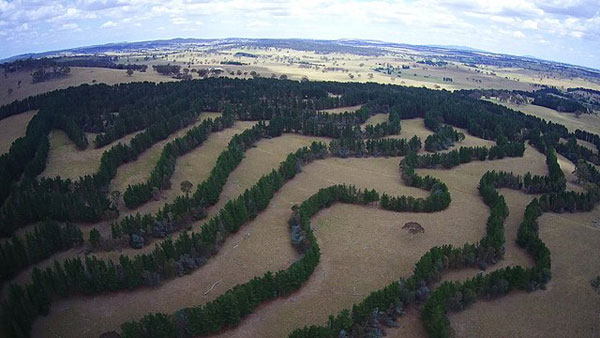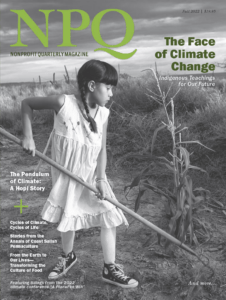
May 9, 2019; Truthout
The 2018 Intergovernmental Panel on Climate Change (IPCC) report gets to the point: We must reduce emissions by 45 percent by 2030, followed by a 2050 goal of net-zero emissions, for the people on this planet to avoid devastation.
NPQ has kept an eye on the Green New Deal, considering such points as nationalizing fossil fuel companies and the technology necessary to achieve zero emissions. It’s apparent there’s a social justice element to the issue of climate change, as low-income neighborhoods and communities of color have been routinely harmed by environmentally induced disasters. Addressing climate change is as much a moral requirement as it is an economic need.
One critical piece in the climate change puzzle is industrialized farming, the source of much of our food. Our current paradigm features massive plant monocultures and constant tilling of the soil, maintained by tractors run by diesel fuel and polluting synthetic fertilizers. The way we produce food is the source for one third of all greenhouse emissions. It does not have to be this way, because plants can do something fossil fuel engines can’t do: They can become part of the chain to pull carbon back from the atmosphere. Through photosynthesis, the right plants planted the right way can take in more carbon, and even store it in the soil.
In the US, the share of emissions coming from agriculture is about nine percent, according to the Environmental Protection Agency, a virtually certain and dramatic underestimate, given the meat industry’s copious unreported methane emissions.
Regenerative agro-ecological methods depend on not tilling the soil, use of diverse cover crops, application of compost, and avoidance of synthetic fertilizers and chemical pesticides. Applying these principles to the more than 900 million acres of US farmland would be a game-changer for the planet. According to the Marin Carbon Project, a single application of natural compost on half of California’s rangeland would increase the capacity for carbon sequestration by 42 million metric tons. Changing farming methods would save the reduction of the world’s topsoil, stop the degradation of watersheds by large contained-animal operations and stop 200,000 deaths a year from pesticides.
Our present farming practices are hard on the farmers. This can be turned around.
As Severine von Tscharner Fleming, a young regenerative farmer, agroecologist and organizer succinctly describes, “We are creating a balanced system that mimics nature, where nature is our measure…there is plenty of room for more people to get out on this landscape and the landscape is calling for those people.”
Sign up for our free newsletters
Subscribe to NPQ's newsletters to have our top stories delivered directly to your inbox.
By signing up, you agree to our privacy policy and terms of use, and to receive messages from NPQ and our partners.
Changes must be made on a grand scale, not the slow process of one farmer at a time. The average age of our current farmers is 60, speaking to both the opportunity and necessity to recruit a new generation of younger farmers who can enact the needed regenerative practices.
In short, we need a Green New Deal for farming. Much more work needs to be done to determine its details, but we can start to sketch its broad contours. Fundamentally, a national paradigm shift to regenerative agriculture will require two related structural transformations: 1) a breaking up of our huge input-intensive, carbon-emitting monocultures in favor of much smaller labor-intensive, carbon-sequestering farms; and 2) the deployment of millions of new farmers to manage these millions of new small and diverse farms.
The paradigm change has room for a guarantee program of federal jobs, growing our food with a diverse workforce working farming co-ops, and supporting conventional family farms. Federal investing in “ecologically informed technical training, modern hand tools, measurement devices, heavy equipment, distribution and sales infrastructure, and perhaps most importantly, farmland, which would need to be made widely available to new farmers.”
For the Green New Deal to work, we also have to look at the ownership of the land.
Agrarian Trust, a nonprofit committed to supporting land access for the next generation of farmers, is experimenting with community-controlled land commons to collectively and democratically own the land, while giving 99-year leases to regenerative farmers. This model prioritizes broader community involvement and investment in local farms, while giving farmers long-term land security and equity interests so that they can fully commit to restoring the land over many decades.
“What would it look like to have a commons of permanent organic farming?” asks Fleming, who is also on the board of Agrarian Trust. “In France now they have a 6,000-acre commons, of permanently affordable, permanently organic farmland…and I think we need one here.”
All of this requires the will of the people, new regenerative farming legislation and policies, and reeducating the agricultural community. Organizations like the Agroecology Research-Action Collective are working on an initial structure to address the production of food.
Regenerative farming by itself will not resolve all of our carbon emissions problems, but it can be an important part of the answer to critical environmental, health and social justice issues rooted in our industrial, corporate food system.—Marian Conway












